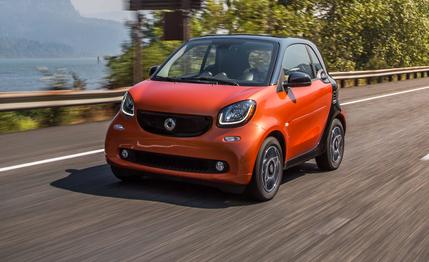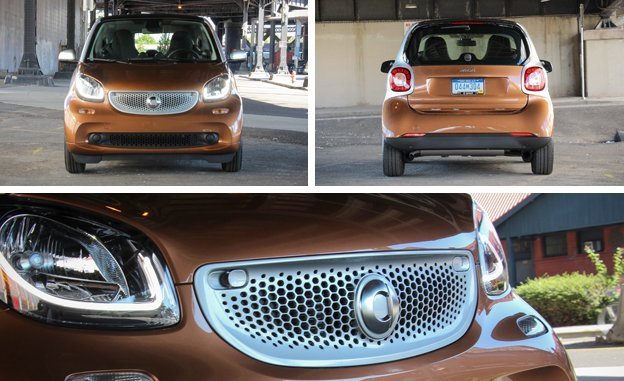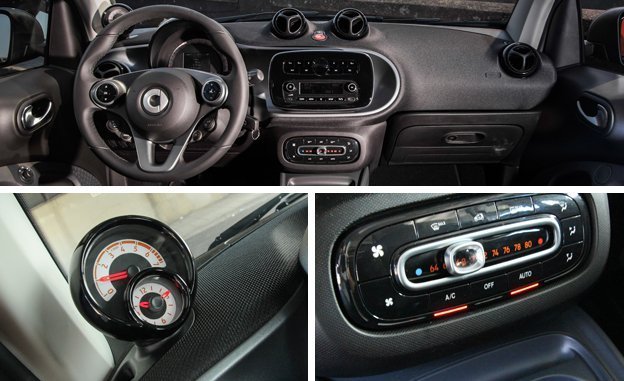 First Drive Review
First Drive Review
There are a few ways to have some fun with a 2016 Smart Fortwo. First, you can park it nose to tail with another Smart in the same single spot. You can also make a U-turn in your driveway. You could engage in a rousing session of Smart-tipping. Finally, you may also choose to drive it on a twisty mountain road.
Wait . . . what?
The first two activities speak to the Fortwo’s premise as the consummate city car, and with its 8.8-foot length and mind-boggling 22.8-foot curb-to-curb turning circle, there is no new car that can perform said tasks better. But the Fortwo’s ability to put a little grin on your face at speed—at least before the rear brake drums fade—is new. Hell, the Fortwo’s ability to even get to speed is new.

We first drove the Fortwo in Europe and found it improved in pretty much every measurable way. While overall length remains the same, the car is nearly four inches wider, yielding much-needed room for when the head count rises above one. The seats are actually comfortable, and the dashboard retains some whimsy but stops short of outright goofiness. New for 2016 is a mobile app called “Cross Connect” that offers vehicle info (including g-forces!) and navigation. For $100 extra, you can get a mount that places your phone in front of the radio. The bad news is that the app is still a little buggy and crashed repeatedly when we used it. The good news? It’s free. Even better, you don’t have to use it until a stable version is released.
The only engine Americans get is an 898-cc turbocharged three-cylinder that spins up 89 horsepower and 100 lb-ft of torque. That’s not a lot of grunt, but it represents a huge increase over the 70 horsepower and 68 lb-ft of last year’s naturally aspirated three-pot. According to Smart, it’s good for a two-second reduction in zero-to-60-mph acceleration times: 10.1 seconds when paired to the five-speed manual and 10.5 with the new six-speed dual-clutch automatic. If you care—or dare—the top speed is 96 mph.
Power is nonexistent below 2000 rpm but rushes in suddenly after that only to drop off a cliff above 5000 rpm. Smoothness takes practice, then, with the standard five-speed manual, a transmission type that’s being offered in a U.S.-market Smart for the first time and the gearbox we spent the majority of our time with. The shifter itself is decent—not Miata snickety, but not so vague that you’ll get lost in the gates. Of course, there aren’t exactly a ton of gates to get lost in, and second gear in particular is so tall that we found ourselves jumping down to first to exit corners in order to prevent bogging. At least our tester’s progressive clutch seemed better calibrated than the on-off switch in the car we drove in Europe.

While our previous experience did not include any extra-urban driving, we did spend some time bombing up and down Skyline Boulevard in Portland, Oregon, and found the steering to be quite well tuned, precise, and not the least bit darty. Dive hard into corners and the Fortwo understeers at first but rotates obediently once it takes a set and gets comfortable with what you’re asking it to do. A spongy, fade-prone brake pedal is a demerit, but compared with the last Fortwo, the 2016 model’s handling is a revelation. A $600 Sport package available on the automatic brings 16-inch wheels (up from the standard 15-inchers), shift paddles, and a 10-millimeter lower suspension. Stay tuned for a test of that model soon.
Indeed, if the 2016 Smart Fortwo’s worth were measured by its ability to make U-turns, it would cost more than a Bugatti Veyron. It is, however, priced somewhat lower, starting at $15,400 for the manual, rising to $16,390 with the automatic, and topping out at the Proxy model, which costs $19,230 with a stick and $20,220 with the automatic. You won’t overspend on gas, either, with fuel economy numbers of 32/39 mpg city/highway for the manual and 33/39 for the automatic. That’s not superimpressive for a car this small, but Smart itself doesn’t play up the Fortwo as an especially green car, at least not before the new Electric Drive model arrives late next year.
As a city car, however, with its ability to create its own parking spots and maneuverability that’s clown-car fun, the 2016 Fortwo has no peers. And now the Fortwo is a considerably less terrible proposition for buyers whose daily drive involves more than making tight turns and squeezing into small spaces.